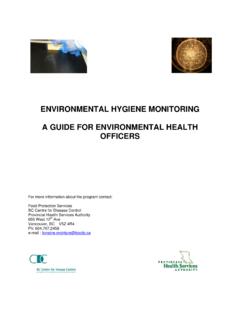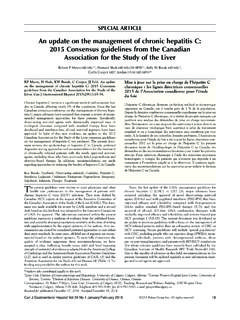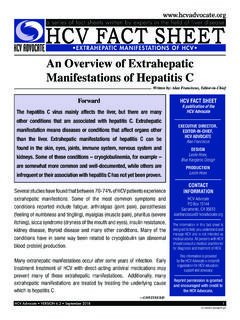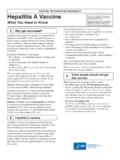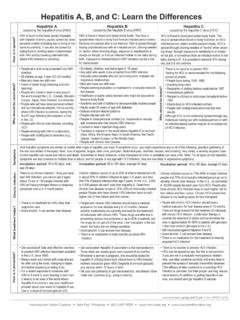Transcription of Hepatitis C: Nutrition Care Q - BC Centre for Disease Control
1 HHHeeepppaaatttiiitttiiisss CCC::: NNNuuutttrrriiitttiiiooonnn CCCaaarrreeeQQQQQQQQQQQQ QQQQQQQQQQQQ QQQQQQQQQQQQ QQQQQQQQQQQQ QQQQQQQQQQQQ QQQQQQQQQQQQ QQQQQQQQQQQQ QQQQQQQQQQQQ QQQQQQQQQQQQ QQQQQQQQQQQQ QQQQQQQQQQQQ QQQQQQQQQQQQ QQQQQQQQQQQQ QQQQQQQQQQQQ QQQQQQQQQQQQ QQQQQQQQQQQQ QQQQQQQQQQQQ QQQQQQQQQQQQ QQQQQQQQQQQQ QQQQQQQQQQQQ QQQQQQQQQQQQ QQQQQQQQQQQQ QQQQQQQQQQQQ QQQQQQQQQQQQ QQQQQQQQQQQQ QQQQQQQQQQQQ QQQQQQQQQQQQ QQQQQQQQQQQQ QQQQQQQQQQQQ QQQQQQQQQQQQCCC aaannnaaadddiiiaaannn GGGuuuiiidddeeellliiinnneeesss fffooorrr HHHeeeaaalllttthhh CCCaaarrreee PPPrrrooovvviiidddeeerrrsssEndorsed by: Canadian Association for the Study of the Liver Canadian Association of Hepatology Nurses Canadian Hemophilia Society Canadian Liver Foundation Hepatitis C Society of CanadaFunding for the development anddissemination of these guidelines wasprovided by Health Canada, CommunityAcquired Infections Division:< >.
2 These guidelines are designed to serve as ageneral framework to assist decisionmaking for nutritional management ofpatients infected with the Hepatitis C virusand are based on the best informationavailable at the time of publication. Theparticular needs of individuals infected withthe Hepatitis C virus will determine howthese guidelines are used. The skill andjudgement of the health care provider isimportant in making health care opinions expressed in this document donot necessarily reflect the official policies orviews of Health 2003, Dietitians of rights document, as well as an onlineprofessional education program and patienteducation handouts, are available from theDietitians of Canada website at< >.
3 Permission is granted to download andreproduce the documents in their disponible en fran ais sous letitre, H patite C : Soins nutritionnels Lignes directrices canadiennes pour lesintervenants de la sant .TTaabbllee ooff iExecutive iiPractice 1 Target Audience for the GuidelinesRationale for the GuidelinesResults of Needs AssessmentHow the Guidelines Were DevelopedChapter 1: A Primer on Hepatitis 3 Description of the IssueWho Is at RiskDiagnosis of HCVC urrent Treatment StrategiesHow HCV Affects the LiverStages of Liver DiseaseFactors Implicated in Progression of Liver DamageThe Role of the Liver in NutritionHow HCV Affects Nutritional StatusChapter 2: Healthy Lifestyle 7 Proven Benefits of NutritionHealthy Eating for Persons Infected with HCVH ealthy Eating Guidelines in CanadaAlcohol and Hepatitis CImportance of a Healthy Body WeightImportance of Physical ActivityChapter 3: Nutrition Intervention in Hepatitis 10 Guidelines for Nutrition Intervention in Hepatitis CNutrient Guidelines OverviewOxidative StressVitamin and Mineral SupplementsStage of Hepatitis C Nutrition ConsiderationsEnteral and Parenteral NutritionChapter 4: Assessment of Nutritional 24 Factors to Consider in Clinical Nutrition EvaluationCounselling Guidelines and RecommendationsChapter 5.
4 Dealing with Symptoms and Treatment Side 29 Common Symptoms and Treatment Side Effects Associated with Hepatitis CStrategies for Coping with Symptoms and Treatment Side EffectsChapter 6: Complementary and Alternative 30 The Naturopathic ApproachVitamin/Mineral SupplementsHerbal ProductsChapter 7: Nutritionally At-Risk 35 Concomitant Medical ConditionsAt-Risk Population or Lifestyle GroupsChapter 8: Skills for Healthy 38 Ability to Plan, Shop and CookNutrition LabellingFood SafetyReferences and 40 References by ChapterResources Organizations and General Useful ResourcesResources by ChapterGlossary of Terms and 58 Appendix A: Healthy Eating Checklist for Persons with Hepatitis CAppendix B: Canada s Food Guide PrinciplesAppendix C: Summary of Physical Activity ConsiderationsAppendix D: Quick Protein CheckAppendix E: Guidelines for Food Selection with Sodium RestrictionAppendix F: Managing Common Discomforts and Treatment Side EffectsAppendix G: Healthy Eating Planning TipsAppendix H: Low-Cost Nutritious ChoicesAppendix I: Standard Nutrition Facts LabelAppendix J: Tips for Safe Food HandlingHepatitis C.
5 Nutrition care Canadian Guidelines for Health care ProvidersiAcknowledgementsMany people have contributed to the development of these guidelines and deserve recognition fortheir time, effort and of Canada sincerely thanks the members of the national advisory committee for their expertadvice and guidance. We also thank the organizations involved in the project, as well as the expertreviewers who provided valuable guidance on the technical and practical aspects of the of the guidelines would not have been possible without the insights of those whoparticipated in the key informant interviews for the needs assessment. We are also grateful to theparticipants in the focus groups conducted to test and refine the patient education AAddvviissoorryy CCoommmmiitttteeeeRen e C.
6 Crompton, , RDRegional Nutritionist Ontario RegionFirst Nations and Inuit Health BranchHealth CanadaMary Giudici, RDNV ancouver Island Health AuthorityRoyal Jubilee HospitalVictoria, BCLynn GreenblattCommunity Acquired Infections DivisionHealth CanadaKelly Kaita, MD, FRCP(C)Director, Viral Hepatitis Investigative UnitUniversity of ManitobaCanadian Association for the Study of the LiverTimothy J. McClemontExecutive DirectorHepatitis C Society of CanadaBillie PotkonjakNational Director of Health Promotionand Patient ServicesCanadian Liver FoundationJeff RiceCoordinator of Regional Resources andHepatitis C ProgramsCanadian Hemophilia SocietyVera Simon, RN, Association of Hepatology NursesJayne Thirsk, , RDProfessional Development and SupportDietitians of CanadaEExxppeerrtt RReevviieewweerrss DDiieettiittiiaannss ooff CCaannaaddaaPauline Brazeau-Gravelle, RDPerinatology Clinical DietitianOttawa Hospital, General CampusOttawa, ONAlison Cummins, RDClinical Dietitian Medicine ProgramHealth Sciences CentreWinnipeg, MBMarylynn Cutten.
7 Food & Nutrition ServicesCapital District Health AuthorityQueen Elizabeth II Health Sciences CentreHalifax, NSLori Hards, RDDietitian/NutritionistSouthern Alberta ClinicCalgary, ABJanet Madill, (C), RDTransplant Dietitian, Research Practice LeaderUniversity Health Network, Toronto GeneralToronto, ONTania Soutar, , RDClinical DietitianRegina Qu'Appelle Health RegionRegina, SKSpecial thanks go to Mary Giudici for sharing her patient education tools, and to the additional expertreviewers: Diana Johansen, , RD, Clinical Dietitian, Oak Tree Clinic, Children s and Women sHealth Centre of British Columbia, and Adjunct Professor, Department of Family Practice, University ofBritish Columbia.
8 And Sian Hoe Cheong, RD, Supervisor, Food Services, Medicine Hat RegionalHospital, Palliser Health MMaannaaggeemmeennttSusan Morgan, , RDProject ManagerJeane EnnisConsultant/Project AssociateSheryl Conrad, RDConsultant/WriterHepatitis C: Nutrition care Canadian Guidelines for Health care ProvidersiiExecutive SummaryThese guidelines are directed to all health care providers who are in a position to offer Nutrition -related advice and guidance to persons infected with the Hepatitis C virus (HCV), in all stages of thedisease. The guidelines are based on the best information available at the time of publication; wherescientific evidence is not available, best-accepted practice is prevalence of HCV infection in Canada is estimated to be about , or 240,000 C is one of the driving forces behind the increasing prevalence of chronic liver Disease .
9 Up to85% of persons exposed to HCV develop chronic liver Disease over a 10- to 40-year period. Associatedmorbidity and mortality are projected to increase dramatically over the next 10 to 15 years. Anincrease in chronic hepatic Disease means potential problems with nutritional deficits in this populationand an important role for Nutrition in the outcome of the PPrriimmeerr oonn HHeeppaattiittiiss CCHCV causes an inflammatory reaction that is localized within the liver, allowing the virus to graduallyinfect and destroy liver tissue, such that liver damage progresses slowly. It is not unusual for someonewho feels well to have serious liver Disease and for someone with severe symptoms to have only mildliver Disease .
10 Liver failure does not become obvious until most of the hepatocytes have beendestroyed. At this point, it becomes difficult for the body to maintain nutritional homeostasis, utilizenutrients appropriately, synthesize plasma proteins, and detoxify noxious LLiivveerr aanndd NNuuttrriittiioonnThe liver significantly influences nutritional status through its role in the intermediary metabolism ofmacronutrients, micronutrients and bile salts. Liver Disease affects nutrient digestion and absorption,storage and metabolism, which can lead to vitamin and mineral deficiencies and protein energymalnutrition (PEM). The degree to which nutritional factors contribute to the progression of liverdisease has not been well established.


